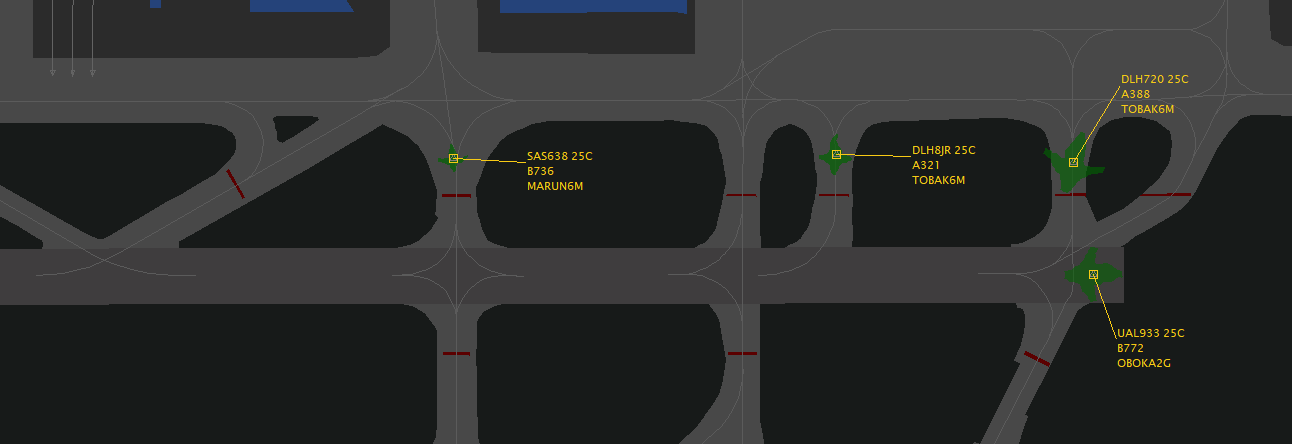Conditional Lineup
Introduction
At all controller stations, it is extremely important to use the frequency as efficiently as possible. In our heads, we may be able to think about and work on two things at the same time, but on frequency, we cannot give two instructions to different aircraft at the same time. This makes it advisable to prioritize transmissions in order to have time for other transmissions later. An ideal option for this is the conditional lineup clearance. It allows you to delegate the clearance to the pilot and instruct him to taxi onto the runway after a certain amount of traffic.
It is important to always tell the pilot exactly which traffic is involved! There must also be good visibility so that the pilot can see the other aircraft. If the weather conditions are poor or the angle of the intersection is unfavorable (more acute than 90°), the pilot must first be asked whether he can see the traffic in question.
As mentioned above, this procedure is intended to make better use of gaps in the frequency and thus increase efficiency. It should be noted that a conditional clearance is significantly longer and takes more time than a standard one. Depending on the traffic situation, a conditional clearance can be significantly more efficient than a normal lineup. If, for example, one can expect that by the end of the call the landing traffic has already flown over the runway threshold or someone else has already started the take-off run, a normal lineup is probably more suitable
For departures
When traffic volumes are high, it can be very important on some airports to achieve efficient spacing of departures and not lose any time. To make this possible, the outbounds should start their lineups as soon as possible. Here, the controller can work well in advance and guide the aircraft onto the runway according to their planned departure sequence.
Several conditional clearances at the same time are only possible if the restricting aircraft is the closest aircraft to the restricted aircraft. This is explained further in the example below.
Example for a conditional lineup in Frankfurt runway 25C (click for full screen)
| Station | Phraseologie |
| ATC | DLH720, after departing Boeing 777, lineup runway 25C behind, number 3 for departure. |
| Pilot | After departing Boeing 777, lining up runway 25C behind, number 3, DLH720. |
| ATC | SAS638, after next departing Boeing 777 full length, lineup runway 25C behind. |
| Pilot | After departing Boeing 777 full length, lineup runway 25C behind, SAS638. |
The words “after" must be mentioned at the beginning and the word "behind" at the end, this needs to be read back by the pilot! If the pilot is not next in the departure sequence and has received a conditional clearance, he should be informed of this position in the sequence (e.g. number 3 for departure) to avoid misunderstandings.
The airline should not be explicitly mentioned in the description of a restricting aircraft. Due to various leasing agreements and other commercial contracts, Lufthansa flights, for example, are often operated by Air Dolomiti aircraft. In this case, mentioning "Lufthansa" would confuse the pilots, as the relevant aircraft actually sports an Air Dolomiti livery. Instead, the description should be based on the aircraft type and position.
The following instruction would not be possible:
| ATC | DLH8JR, behind departing company Airbus A380 via L3, lineup runway 25C and wait behind, number 4. |
Simultaneous conditional clearances are only possible if the restricting aircraft is the next aircraft taxiing past the restricted aircraft. In this case, the restricting aircraft for the DLH8JR would be the DLH720. However, DLH720 is not the first aircraft to roll past DLH8JR, as UAL933 starts its take-off run first and thus rolls past DLH8JR. The conditions are therefore not met.
For approaches
In order to use the gap between two approaches for a departure (see also Tower efficiency), the lineup needs to take place as soon as possible after the first landing aircraft has crossed the runway threshold. This allows the take-off clearance and take-off run to take place as soon as the landing aircraft has left the runway.
| Station | Phraseologie |
| ATC | DLH5KC, behind next landing A320 on 2 NM final, lineup runway 26L behind. |
| Pilot | Behind next A320, lining up runway 26L behind. |
As stated before, the airline should not be explicitly mentioned in the description of the aircraft. Due to various leasing agreements and other commercial contracts, Lufthansa flights, for example, are often operated by Air Dolomiti aircraft. In this case, mentioning "Lufthansa" would confuse the pilots, as the relevant aircraft actually sports an Air Dolomiti livery.
The same rule stated above also applies here: Several simultaneous conditional clearances are only possible if the restricting aircraft is the next aircraft taxiing past the restricted aircraft. For example, a conditional lineup behind a landing aircraft may not be issued if an aircraft will still taxi past the waiting aircraft during the take-off run before the restricting landing aircraft.

